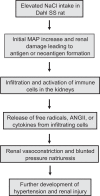Infiltrating immune cells in the kidney in salt-sensitive hypertension and renal injury
- PMID: 25007871
- PMCID: PMC4154114
- DOI: 10.1152/ajprenal.00258.2014
Infiltrating immune cells in the kidney in salt-sensitive hypertension and renal injury
Abstract
The importance of the immune system in hypertension, vascular disease, and renal disease has been appreciated for over 50 years. Recent experimental advances have led to a greater appreciation of the mechanisms whereby inflammation and immunity participate in cardiovascular disease. In addition to the experimental data, multiple studies in patients have demonstrated a strong correlation between the observations made in animals and humans. Of great interest is the development of salt-sensitive hypertension in humans with the concurrent increase in albumin excretion rate. Experiments in our laboratory have demonstrated that feeding a high-NaCl diet to Dahl salt-sensitive (SS) rats results in a significant infiltration of T lymphocytes into the kidney that is accompanied by the development of hypertension and renal disease. The development of disease in the Dahl SS closely resembles observations made in patients; studies were therefore performed to investigate the pathological role of infiltrating immune cells in the kidney in hypertension and renal disease. Pharmacological and genetic studies indicate that immune cell infiltration into the kidney amplifies the disease process. Further experiments demonstrated that infiltrating T cells may accentuate the Dahl SS phenotype by increasing intrarenal ANG II and oxidative stress. From these and other data, we hypothesize that infiltrating immune cells, which surround the blood vessels and tubules, can serve as a local source of bioactive molecules which mediate vascular constriction, increase tubular sodium reabsorption, and mediate the retention of sodium and water to amplify sodium-sensitive hypertension. Multiple experiments remain to be performed to refine and clarify this hypothesis.
Keywords: hypertension; infiltrating immune cells.
Copyright © 2014 the American Physiological Society.
Figures




References
-
- Alvarez V, Quiroz Y, Nava M, Pons H, Rodríguez-Iturbe B. Overload proteinuria is followed by salt-sensitive hypertension caused by renal infiltration of immune cells. Am J Physiol Renal Physiol 283: F1132–F1141, 2002 - PubMed
-
- Ba D, Takeichi N, Kodama T, Kobayashi H. Restoration of T cell depression and suppression of blood pressure in spontaneously hypertensive rats (SHR) by thymus grafts or thymus extracts. J Immunol 128: 1211–1216, 1982 - PubMed
-
- Bendich A, Belisle EH, Strausser. Immune system modulation and its effect on the blood pressure of the spontaneously hypertensive male and female rat. Biochem Biophys Res Commun 99: 600–607, 1981 - PubMed
-
- Bigazzi R, Bianchi S, Baldari D, Sgherri G, Baldari G, Campese VM. Microalbuminuria in salt-sensitive patients. A marker for renal and cardiovascular risk factors. Hypertension 23: 195–199, 1994 - PubMed
-
- Bravo Y, Quiroz Y, Ferrebuz A, Vaziri ND, Rodriguez-Iturbe B. Mycophenolate mofetil administration reduces renal inflammation, oxidative stress, and arterial pressure in rats with lead-induced hypertension. Am J Physiol Renal Physiol 293: F616–F623, 2007 - PubMed
Publication types
MeSH terms
Substances
Grants and funding
LinkOut - more resources
Full Text Sources
Other Literature Sources
Medical
Miscellaneous

